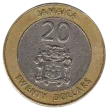Exchange your Jamaican Dollars
Do you have leftover Jamaican Dollars? We offer a fast and easy way to exchange both current and withdrawn Jamaican Dollar banknotes and coins. Convert them into your local currency today with our quick and hassle-free exchange service.
$ - JMD
The Jamaican Dollar has been in use since 1969 and remains a key part of Jamaica’s financial system.
Jamaican Dollars Information
The Jamaican Dollar (JMD) is the official currency of Jamaica, an island nation in the Caribbean. It was introduced in 1969, replacing the Jamaican pound. The change from the pound to the dollar was part of Jamaica’s efforts to modernise its economy following independence from the United Kingdom in 1962. Since then, the Jamaican Dollar has played a central role in the country’s economy, supporting both domestic transactions and international trade.
The Jamaican Dollar is subdivided into 100 cents, and the currency is issued in both coins and banknotes. Coins are available in denominations of 1, 10, and 25 cents, as well as 1, 5, 10, and 20 dollars. Banknotes are issued in denominations of 50, 100, 500, 1,000, and 5,000 dollars. The designs on Jamaican banknotes often feature prominent national figures, such as political leaders and cultural icons, along with depictions of important Jamaican landmarks and symbols, including images of the country’s famous flora and fauna.
Jamaica’s economy is primarily based on sectors such as tourism, agriculture, mining, and manufacturing. The stability of the Jamaican Dollar is essential for supporting these industries, particularly tourism, which is one of the largest contributors to Jamaica’s GDP. Tourists visiting Jamaica often use the Jamaican Dollar for local transactions, although the U.S. Dollar is also widely accepted in major tourist areas. Jamaica is also known for its agricultural exports, including sugar, coffee, and bananas, which have long been a cornerstone of its economy.
The Bank of Jamaica is responsible for issuing the Jamaican Dollar and managing the country’s monetary policy. The central bank’s primary goal is to maintain price stability and low inflation, which are crucial for preserving the value of the currency. Over the years, the Bank of Jamaica has implemented a range of economic reforms aimed at modernizing Jamaica’s financial system, encouraging foreign investment, and promoting economic growth. These efforts have helped to strengthen the Jamaican Dollar and support the country’s economic development.
Despite its role in supporting the Jamaican economy, the Jamaican Dollar has faced challenges in recent years due to fluctuations in global markets and the impact of external factors such as the COVID-19 pandemic. Jamaica’s reliance on tourism and exports makes the currency vulnerable to changes in global demand. However, the Jamaican government has worked to mitigate these risks by diversifying the economy and implementing measures to improve the resilience of the Jamaican Dollar.
In conclusion, the Jamaican Dollar has been the official currency of Jamaica since 1969. It remains a stable and trusted currency, reflecting Jamaica’s economic progress and its importance in the Caribbean region.











